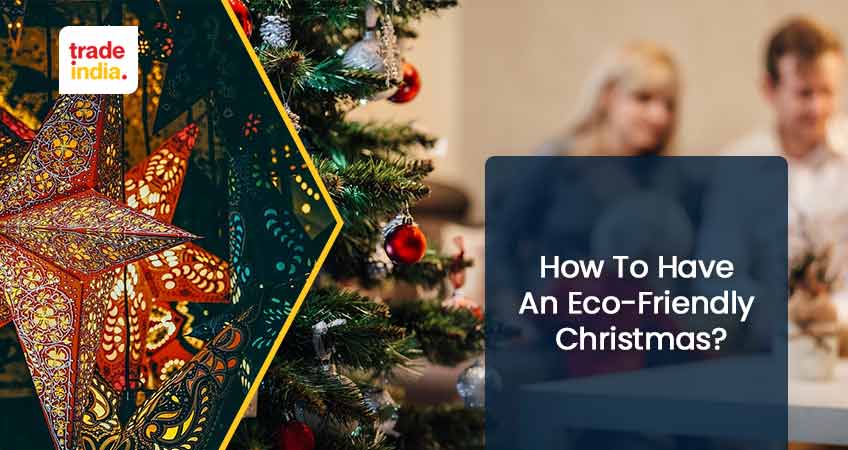
Celebrating Christmas should not be harmful to the environment. You can lessen Christmas's negative effects on the planet with just a little creativity and planning.
Personal, one-of-a-kind presents are a great way to show appreciation without breaking the bank. While younger children might prefer the flashy store-bought present, adults value any gesture of care and consideration. Use what you already have to deck the halls this holiday season. If you want something that will endure a long time, you should either make it yourself out of recycled materials or buy it at a craft market.
Top 18 Ways for an Eco-Friendly Christmas
1. Remember the True Meaning of Christmas
Ponder the holiday's true meaning. Does it have anything to do with the presents, the overabundance of food, the decorations, or the glitzy attire? Or is it being with family and friends, thinking about the past year and the year to come, and counting one's blessings?
2. Source a Sustainable Tree, Then Dispose of Its Responsibility
It's important to seek the FSC logo to ensure your actual tree comes from a responsible source. If you're worried about your eco friendly ornaments status, you should also see if it has Soil Association certification. Real Christmas trees should be recycled or disposed of in a local landfill where they will be processed and (eventually) converted into something new.
If you've decided that an artificial tree is more your style, consider purchasing a used one from a site like eBay, Gumtree, or Facebook Marketplace instead of a brand new one.
3. Think About the Drink
Avoid letting your environmental concerns prevent you from enjoying a glass of wine this holiday season; the organic wine industry in the United Kingdom is expected to more than quadruple by 2022, so you'll have plenty of options. For wine, I recommend either the London-based Forty Hall Vineyard or the Kent- and Sussex-based Davenport Vineyards. Try some of the organic whiskey, brandy, and gin produced at Dà Mhle, the first organic distillery in the UK, located in southwest Wales, if you're looking for something stronger.
Not enough drinkware for the party? Rent some for free from Waitrose instead of buying disposable ones. For further information about the store's lending service, please contact a local branch.
4. Choose Decorations That Will Last a Lifetime
Instead of using non-recyclable materials like plastic or PVC, repurposed wood, cloth, and glass ornaments are fantastic alternatives. I suggest going with timeless designs for your holiday decorations instead of trendy ornaments that will be old news by next year's holiday season.
5. Think About Your Outfit
Instead of spending your hard-earned money on sequins (which are created from PVC and have no biodegradable alternatives), consider using sustainable materials. Consider, The Reformation, or Maya Miko if you're searching for environmentally conscious, bold designs. Even after Christmas, you'll probably still want to wear them. Alternately, download one of the many clothing-switching applications available.
6. Opt for Eco-Friendly and Fairtrade Gifts
It's easy to get carried away during the holiday shopping of eco friendly trees season, but if you care about the environment and the fair treatment of workers, try to rein yourself in. If you're looking for a fun twist on the traditional holiday gift exchange with loved ones, consider recommending a Secret Santa. Rather than scattering your budget among several less meaningful items, you may put that money toward one thoughtful present.
7. Use Plant-Based Glitter
Eco Glitter Fun makes a vegan, plant-based glitter that you may use if you just can't live without a little sparkle. Packaging materials include shredded newspaper, paper packing tape, and cardboard, all of which are derived from recycled materials. All of their biodegradable glitters are sold in glass containers.
8. Plan Your Christmas Dinner to Minimize Waste
Every year, many pounds of food are wasted because hosts over-buy in anticipation of Christmas. For many, not having enough food for Christmas is the worst possible scenario. To minimize impulse purchases and waste, it's important to make a list before heading to the store. If you find yourself with leftovers or observe food spoiling before you get a chance to consume it, give it some serious thought before tossing it out. While the British may make light of turkey curry on Boxing Day, it's actually a terrific way to make use of leftovers and cut down on waste.
9. Switch to Led Christmas Lights
LEDs are superior to incandescent Christmas lights because they consume up to 80% less energy while still providing the same level of brightness. Put both your indoor and outdoor lights on a timer, and consider switching to solar electricity. You'll be able to lower your impact on the environment and your energy costs simultaneously.
10. Cook Less Meat and Source Ingredients Consciously
Maybe more controversially for the carnivores among people, as become more conscious of the influence your meat consumption has on the planet, you should think about cutting back on your consumption of meat not just on Hanging Christmas Ornaments but throughout the holiday season as a whole. However, your effect is not limited to the foods you consume; the sources you use have a difference as well. The easiest method to know that no dangerous pesticides were used throughout the growing process of your meat and vegetables is to choose organic options.
11. Invest in a Reusable Advent Calendar
Buy an advent calendar that can be used year after year and stock it with treats like homemade truffles. Indulge your pet dog with a calendar just as much as you would for yourself. An additional fantastic eco-friendly ornament for the holiday season.
12. Take Reusable Bags for Christmas Shopping
Many of us have been inspired by the 5p plastic bag levy to always have a reusable bag on hand; being prepared for Christmas shopping in this way can further limit your plastic usage (and save you a pound or two).
13. Opt for Natural Christmas Candles
Whether you light candles as part of advent or to make a space seem cozy in the colder months, it's important to consider the effect they have on air pollution and your health. Candles are a significant part of Christmas. Rather than using candles manufactured with paraffin, I suggest switching to ones created with natural wax, which is both environmentally friendly and safer to burn.
14. Think About Your Wreath
There's no denying that Christmas wreaths are stunning decorations, but some are eco-friendlier than others. Don't hang wreaths with tinsel or plastic ornaments. Not only are they created from toxic, nonrenewable materials, but they may also kill birds and other wildlife if placed outside. The best option is a wreath created from seasonal, natural materials that have just been made. What's better is to make your own from durable cloth that you can keep using year after year.
15. Avoid Disposable Cutlery, Crockery, and Cups When Hosting
If you're throwing a Christmas party with Christmas Tree Ornaments for a large group of people but don't have enough silverware, plates, or cups, a convenient option is to buy disposable items that can be tossed after use. Many of these plastic objects, however, are not recyclable and must be disposed of in landfills. One option is to have guests bring their dishes, glasses, and utensils, which can then be returned to their owners when the event is over.
16. Buy an experience
Who says presents have to be actual things? A one-year membership to a popular streaming service like Audible or Netflix is a thoughtful gift for a friend or family member. Museum, movie theater, or National Trust membership subscriptions are other great options. A night at the theater, dinner at their favorite restaurant, afternoon tea, a concert, a weekend away, or a comedy show would all be well-received gifts.
17. Use Old Newspapers
Use old newspapers you have sitting around as cheap and easy wrapping material. In the weeks coming up to the holiday, skim through and bookmark any pages that catch your eye. Some of the best places to do this are in the cartoons and puzzles categories. You may also utilize old maps, periodicals, and sheet music. Make your own holiday cards out of the leftovers.
18. DIY Your Tree
Make a creative Christmas tree out of things you already have instead of buying one. Make it three-dimensional by stringing together twigs, branches, and sticks and displaying it on the wall or ceiling.
Conclusion
This time of year, namely around Christmas, is the most wasteful. That's the equivalent of nearly 100 million trash bags delivered to the dump, which adds to air pollution and climate change. This page contains pebble's best advice for a greener Christmas in 2022 and beyond if you're looking to tread lightly without turning into a Grinch.
FAQs: Eco-Friendly Christmas
Q. Is it possible to have an eco-friendly Christmas?
Ans. Yes, In January, you may recycle or compost your cards, or you can reuse them as holiday decorations the next year. Substitute reusable crackers for disposable ones. Some are constructed from pure linen, while others include space for your own special touches.
Q. How can we be more sustainable for Christmas?
Ans. Examine the materials that the presents are manufactured from with an eye toward long-term use and reuse. Look for certifications such as "Organic" on food and clothes, buy only furniture and paper produced from recycled or Forest Stewardship Council (FSC) certified materials, and so on.
Q. What's the most eco-friendly Christmas tree?
Ans. Get a real tree from a local farm or have one planted by a local business, and then adorn it with secondhand, homemade, or biodegradable ornaments for the most environmentally responsible holiday display possible. Everyone benefits from its attractiveness, its festivity, and its long-term viability.
Q. Are fake plants eco-friendly?
Ans. No, many retail outlets claim that their plastic plants are comprised of PE or polythene. Besides polystyrene (thermocol), other common construction materials include ceramics, foam, metal, and even wood. These synthetic plants are made mostly of polyethylene, the most widely used type of plastic in the world.

![How To Start a Wedding Saree Business in India? [Investment, Profit]](/blog/content/images/size/w400/2022/11/How-To-Start-a-Wedding-Saree-Business-in-India.jpg)



